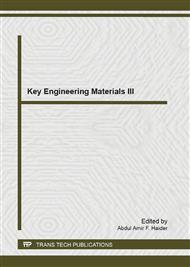p.37
p.42
p.47
p.53
p.59
p.64
p.71
p.77
p.82
Environmental Stress Cracking Resistance (ESCR) of Rubber-Toughened Polyester-Kenaf Composites under Active Environment
Abstract:
This study was undertaken to investigate mechanical and morphological properties of rubber toughened polyester composite filled with kenaf and was exposed in varying natural weathering and difference environmental condition (Artificial Sea Water (SW), Distilled Water (DS), Environment Exposure (EX) and Soil Exposure (SL)). Rubber-toughened polyester-kenaf fibre composites were prepared by adding 25% of kenaf fibre in unsaturated polyester resin and cross linked with a mixture of methyl ethylketone peroxide and cobalt octanoate. Three percent (3%) of liquid natural rubber (LNR) were added as a toughening agent. The sample was prepared using compression molding technique. It was found that the samples that being immersed in seawater (SW) had lower mechanical properties values as compare with other conditions. The value of flexural modulus and flexural strength were decrease by 35.9 % , 12.5% but the value of impact strength had slightly increase by 34% .The microstructures of the composites fracture surface were examined using a scanning electron microscope (SEM).
Info:
Periodical:
Pages:
59-63
Citation:
Online since:
May 2013
Keywords:
Price:
Сopyright:
© 2013 Trans Tech Publications Ltd. All Rights Reserved
Share:
Citation:


